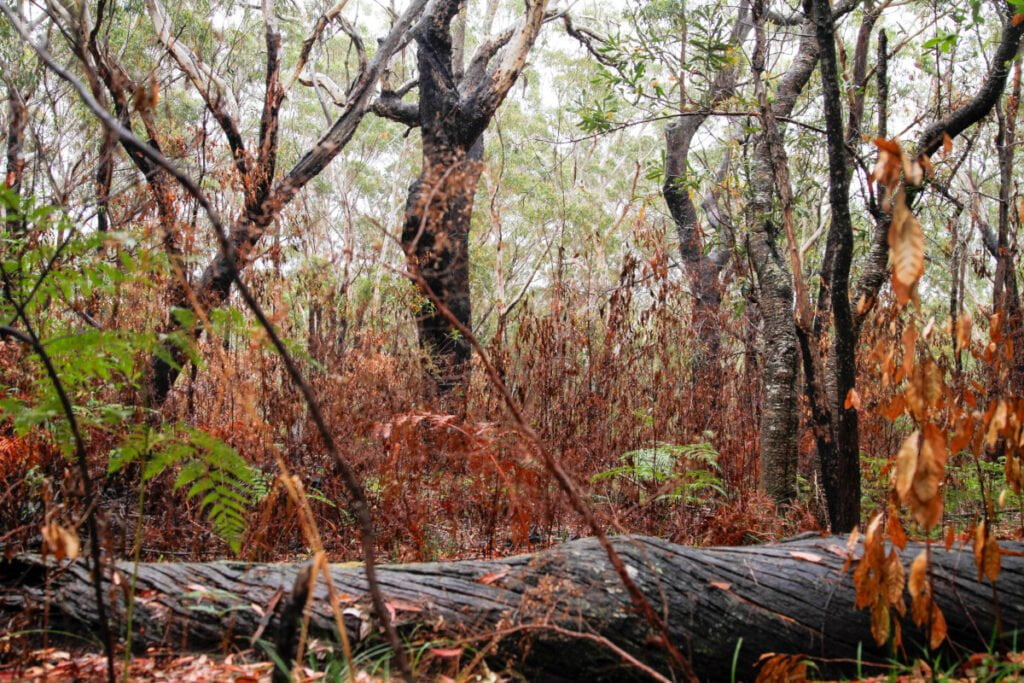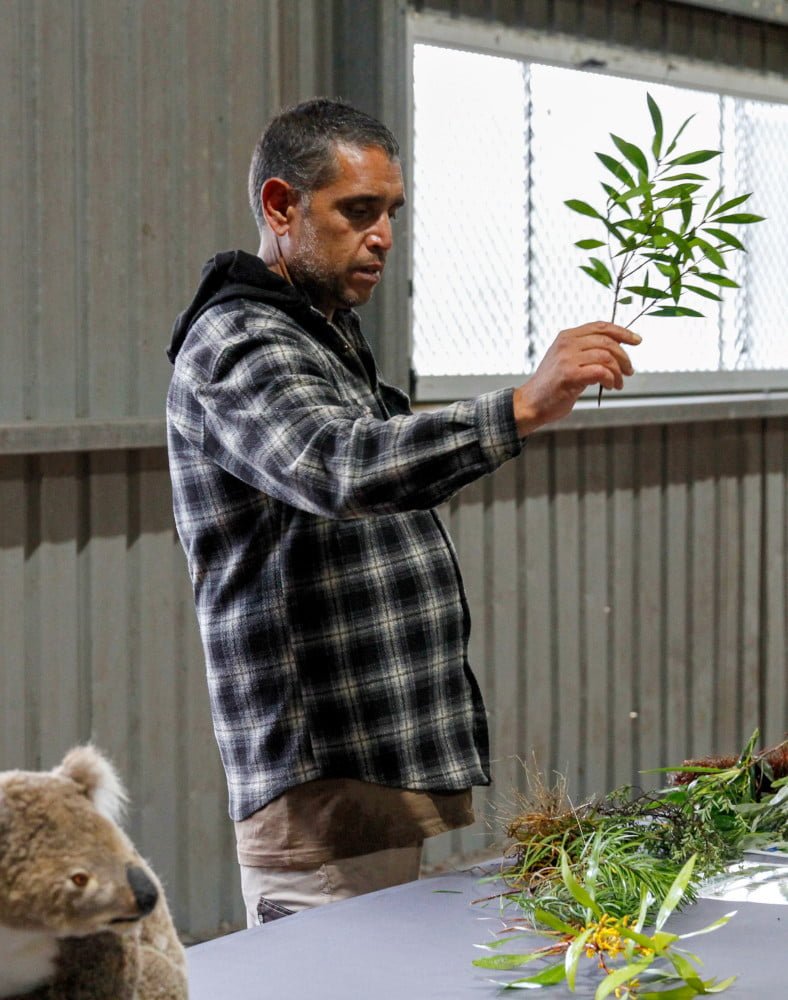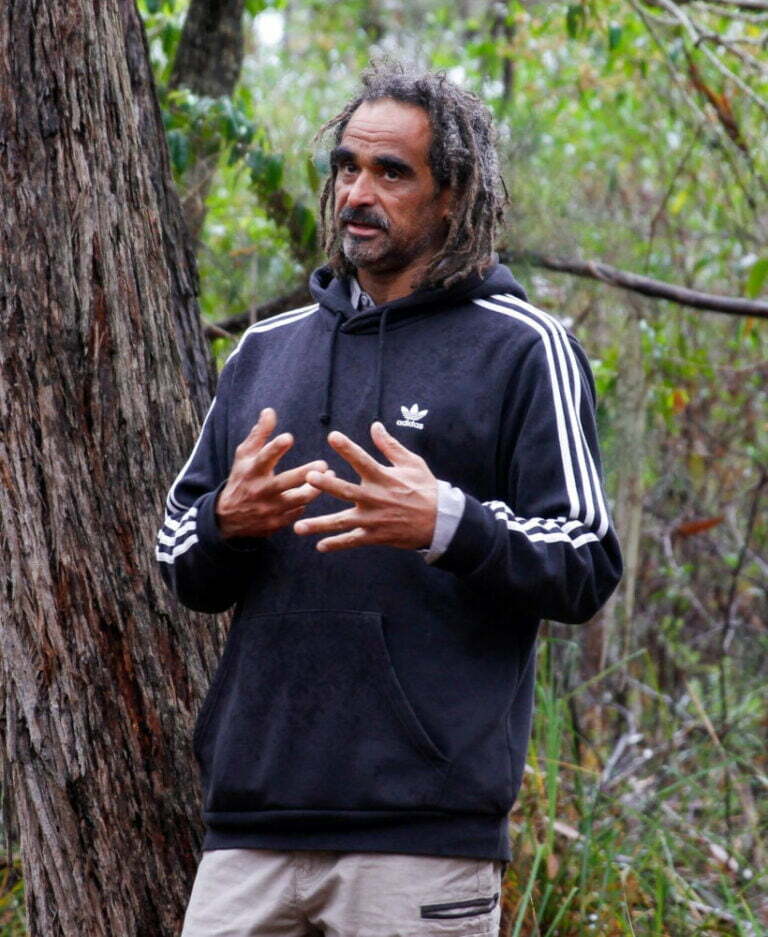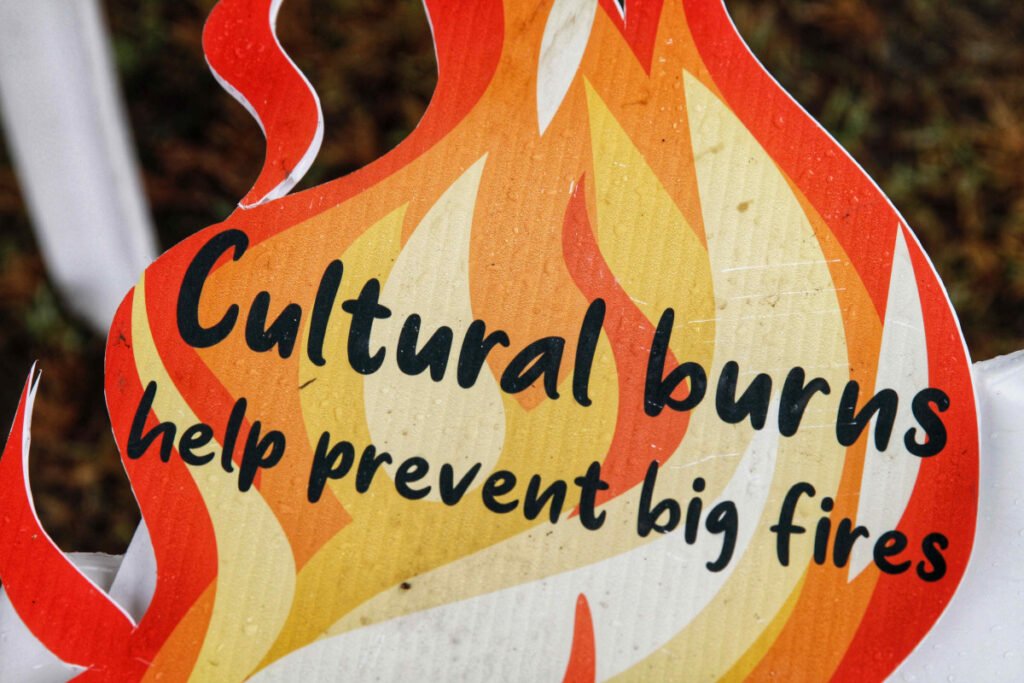Caring for Country – with a cool burn
By Ewa Meyer, Renew Hunter Region Branch. Photos: Tamara Penniket.
What a day for a cool burn workshop! Despite rain and strong winds, around 60 of us attended this special Caring for Country community event on 26 October to learn about the benefits of a culturally-informed cool burn – a low-intensity fire designed to improve land health, re-establish appropriate fire regimes, and reduce the risk and impact of wildfires. I was thrilled to participate as I have always hoped that First Nations Peoples, who have managed this land for thousands of years, are given the opportunity and support to teach us newcomers how to look after Country. The day was very informative, inspiring and gave us hope for the future of land management using traditional methods. As Port Stephens is known for its koalas, the workshop included presentations on koala conservation. We want to recognise the value and importance of working in collaboration with First Nations peoples to embed their place, roles and wisdom in koala conservation.
The workshop was hosted by Port Stephens Council which supports an Aboriginal-led working group to develop a ‘Culturally-informed Cool Burn’ fire management strategy over the next 3 years, and was delivered in partnership with Worimi Local Aboriginal Land Council, Firesticks Alliance Indigenous Corporation, and Hunter Local Land Services. The project involving Firesticks Alliance has been funded by the NSW Government through its Environmental Trust funding program.
Held at the Mallabulla Sports Complex adjacent to where the first series of cool burns is being conducted, the community workshop component helps to further educate and engage the community on this important practice. This program will also be conducted at Anna Bay starting next year.
The Program aims to restore kinship and care for Country while improving the core ecological health of the burn sites and support a diverse flora and fauna community. These burns also aim to reduce potential movement barriers for koalas, and to mitigate the amount of low vegetation for pest fauna that may predate on this and other threatened species. By burning only the ground layers, trees remain undamaged, leaves unburnt and arboreal species, birds as well as other wildlife can continue to use the area.
Introduction
As part of the world’s oldest living culture, First Nations peoples are owners and custodians of the Australian continent and adjacent islands. They share a unique bond to Country – a bond forged through thousands of years of occupying, managing and travelling across lands and waterways for ceremony, religion, trade and seasonal travel. For First Nations peoples, Country takes in everything within the physical, cultural and spiritual landscape – landforms, waters, air, trees, rocks, plants, animals, foods, medicines, minerals, stories and special places. It includes law, kinship, cultural practice, knowledge, songs, stories and art, as well as spiritual beings, and people: past, present and future.
First Nations peoples maintain a core belief that when Country is cared for the right way and is healthy, so is everything and everyone else. Conservation practice is inherent within Aboriginal and Torres Strait Islander cultures. Their land management practices have been influencing and protecting biodiversity health for many millennia.1
How the day unfolded
Under the marquee shelter on the edge of Worimi land, we were welcomed to Country by Worimi Elder, Uncle John Ridgeway, a passionate custodian of the Worimi language and the conservation of the Stockton sand dunes. Uncle John is well known for his friendly demeanour, soulful voice and the unique guitar music he brings to both Indigenous and non-Indigenous communities throughout Worimi Country.

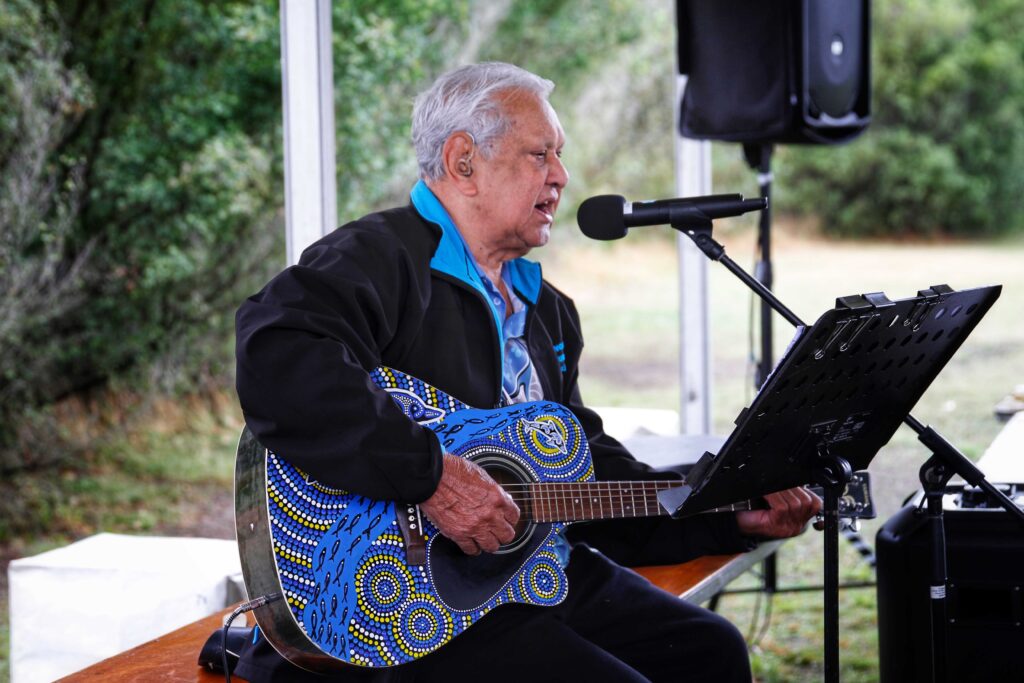
Photo: Cassandra Kottaras from Port Stephens Council was rather chuffed to be introducing Uncle John!
Next we took a tour of the Mallabula burn site led by Worimi woman and Firesticks Associate, Whitney Ridgeway from Hunter Local Land Services. Whitney outlined the changes and benefits on Country following the cool burn that was undertaken in June 2023. She spoke passionately about how her people feel about Country and how they need to be given more opportunities to manage it. Whitney fielded questions about how this particular burn was carried out, and the role that fire has had on weed management in the area. Whisky Grass is a severe weed problem at this location, as well as the native Hop Bush which continues to blanket the unburnt sections. The difference between the burnt and unburnt areas was significant and we were pleased to see that no trees had been damaged by fire at all as they often are when hotter fire management practices are undertaken.



Returning to the community centre, we enjoyed a presentation by Firesticks Lead Fire Practitioner, Peter Townsend about the plants used by Aboriginal people for thousands of years including for food, medicines, tools and other uses. Peter is a Traditional custodian of the Wiradjuri, Wayilwan and Gamilaraay Nations of Western and North Western NSW. Here are some of the plants that Peter spoke about:
- Several Geebung species are commonly used by the Worimi.
- Acacia longifilia can create a sort of soap which is then is used to deoxygenate water to cause fish to float to the surface for an easy catch.
- Acacia binervia is a hard wood and good for making tools.
- Dianella species are used for weaving baskets or hats.
- Using Teatree for colds and sinuses is not a new idea!
- Banksia cones are used to start burns.
Following lunch and presentations about local koala conservation programs, we enjoyed a talk about the work of the Firesticks Alliance by Dan Morgan who is a Djiringanj Yuin Traditional Custodian. Ten years ago in Cape York, Dan met Firesticks Alliance co-founder, the inspirational Victor Steffensen – and he has been an advocate for cultural fire ever since. Dan is now the Koala and Fire Research Program Coordinator for the Firesticks Yuin team.
The Firesticks Alliance trains practitioners in the traditional cool burning of forests and grasslands. Unlike hazard reduction, cool burns are done more frequently as conditions demand. This keeps both man-made assets and natural systems safe. For example, a burn can be done soon after heavy rain while the ground is still wet. It is important not to damage the soil or the trees – only burn the low vegetation. Hazard reduction is implemented to reduce fuel loads but in many cases, it actually increases some mid-storey vegetation species (such as Hop Bush) which thrive after a hot fire.
We’ve all heard about mosaic burning. As Dan explained, this can be done by vegetation type as well as by location. Country will determine when stringybark forests are ready – it may be a different time of year than other forest systems such as ironbark or angophora.
A key aim of cool burns is to establish and maintain healthy soil, which promotes a diversity of culturally and ecologically important plant species to grow and support a healthy ecosystem.
‘Cultural burns need to occur when Country tells us when and what to burn. If we manage the river systems, the forests, the grasslands correctly, then it will help protect human assets.’
Cultural burns are not being implemented as frequently as we would like them to be on public lands due to restrictions imposed by regulations.
Dan and the Firesticks Team believe we should not use the term ‘fighting fire’. Fire will protect us – we need to work with it. If fire management is there to protect assets, the question is ‘are hazard reduction burns working?’
Let’s form more partnership projects between local communities, councils, RFS, NPWS and Indigenous ranger groups. The sooner we start supporting this practice at a community level the healthier and safer it will be for our natural and built environments – and for all of us.
Our take home message
Caring for Country the right way means centring Indigenous knowledge in land management.
‘The answer is to get mainstream solutions and to have the Rural Fire Services and the national parks to be able to work with Indigenous knowledge,’ says Firesticks co-founder Victor Steffensen.
‘We did a lot of burns in New South Wales over the last three years, and particularly just after heavy rain. That’s why it’s so important … because we’re re-skilling and creating the practitioners of the future that will be burning and looking after the country full time.’
Amid a climate crisis, it’s clear we need Indigenous knowledges more than ever. In the last 12 months, Firesticks has:
- Enrolled over 100 Indigenous Fire Practitioners into its mentoring program.
- Celebrated Indigenous knowledges with over 600 people at the National Custodians of Country Gathering.
- Provided 14 Indigenous people with culturally-appropriate employment opportunities.
Victor Steffenson encourages us to see the positive effects of putting Cultural Fire on Country – the way our old people did for thousands of years. Country is slowing healing, and communities are being empowered with cultural knowledge. What Firesticks is doing is working, but they need your valuable support to train the next generation of Indigenous Fire Practitioners to look after Country with Cultural Fire. Please donate to Firesticks here: firesticks.raisely.com
References:
1 Source: NSW Department of Planning and Environment 2022, Koala habitat restoration guidelines: A practical guide to identify, connect and restore koala habitat in New South Wales.
Cultural burning: healthy communities, healthy landscapes – Firesticks Alliance
www.facebook.com/firesticksalliance
Port Stephens community, culture and kinship come together
Talk is cheap, time for action: Yuin man promotes traditional fire management practices – National Indigenous Times January 2020
Before the colonists came, we burned small and burned often to avoid big fires. It’s time to relearn cultural burning – The Conversation June 2023


